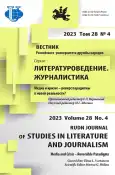Журналистика и искусственный интеллект: реверс парадигмы взаимодействия человека и машины. Картирование новой сферы критических исследований медиа
- Авторы: Шилина М.Г.1,2, Волкова И.И.3, Бомбин А.Ю.4, Смирнова А.А.4
-
Учреждения:
- Российский экономический университет имени Г.В. Плеханова
- Московский государственный университет имени М.В. Ломоносова
- Российский университет дружбы народов
- Санкт-Петербургский государственный экономический университет
- Выпуск: Том 28, № 4 (2023): Медиа и кризис – реверс парадигмы в новой реальности?
- Страницы: 757-768
- Раздел: Журналистика
- URL: https://journal-vniispk.ru/2312-9220/article/view/319111
- DOI: https://doi.org/10.22363/2312-9220-2023-28-4-757-768
- EDN: https://elibrary.ru/IWYVNU
- ID: 319111
Цитировать
Полный текст
Аннотация
В исследовании впервые предпринята попытка обозначить базовые концептуальные параметры журналистики, опосредованной искусственным интеллектом (ИИ). Изучены технологические изменения и коммуникативные трансформации в этой области, которые влияют на социум и социальные перемены. Выявлен кризис человеко-машинного взаимодействия в журналистике, опосредованной искусственным интеллектом, который априори заложен в сущность процесса обработки информации алгоритмами. Парадигмы обеих журналистик - классической и опосредованной искусственным интеллектом - основаны на человеко ориентированном подходе, однако ИИ-парадигма реверсивна. Журналистика предполагает передачу личных взглядов и опыта через фильтр памяти. Алгоритмы функционируют без учета нюансов личной и социальной памяти, тем самым разрушая основные принципы журналистской профессии. Утрата подлинной, «аналоговой» памяти журналистами и их аудиториями и специфика цифровой «памяти» алгоритмов ставят под угрозу фундаментальную социальную роль журналистики в поддержании общественного порядка. Переосмысливая феномен ИИ как коммуникацию человека и машины, человека и алгоритмов, авторы предлагают ввести термин «журналистика коммуникативного искусственного интеллекта». На базовом технологическом уровне термин основан на различных формах автоматизации и встроен в цифровые инфраструктуры; на социетальном уровне - предназначен для центральной цели журналистики и вплетен в человеческие практики. Оба уровня обратимы. Предложенный термин мог бы служить обобщающим, зонтичным для совокупности журналистской деятельности, основанной на искусственном интеллекте. Термин устраняет противоречия не только в человеко-машинном общении, но и проясняет суть применения ИИ в журналистике, исследованиях медиа и для пользователей. Появление и расширение медийных практик, основанных на ИИ, предполагает появление иных кризисных концептуальных противоречий. Обозначенные реалии провоцируют формирование новых областей исследований медиа и в частности возникновение критических исследований медиа, опосредованных искусственным интеллектом.
Об авторах
Марина Григорьевна Шилина
Российский экономический университет имени Г.В. Плеханова; Московский государственный университет имени М.В. Ломоносова
Автор, ответственный за переписку.
Email: marina.shilina@gmail.com
ORCID iD: 0000-0002-9608-352X
доктор филологических наук, профессор, профессор кафедры рекламы, связей с общественностью и дизайна, Российский экономический университет имени Г.В. Плеханова; профессор кафедры рекламы и связей с общественностью, факультет журналистики, Московский государственный университет имени М.В. Ломоносова
Российская Федерация, 115054, Москва, Стремянный пер., д. 36; Российская Федерация, 125009, Москва, ул. Моховая, д. 9, стр. 1Ирина Ивановна Волкова
Российский университет дружбы народов
Email: volkova-ii@rudn.ru
ORCID iD: 0000-0002-2693-1204
доктор филологических наук, профессор, профессор кафедры массовых коммуникаций, филологический факультет
Российская Федерация, 117198, Москва, ул. Миклухо-Маклая, д. 6Андрей Юрьевич Бомбин
Санкт-Петербургский государственный экономический университет
Email: bombin.a@unecon.ru
ORCID iD: 0000-0002-1151-7721
старший преподаватель, кафедра коммуникационных технологий и связей с общественностью
Российская Федерация, 191023, Санкт-Петербург, набережная канала Грибоедова, д. 30-32Анна Андреевна Смирнова
Санкт-Петербургский государственный экономический университет
Email: smirnova.aa@unecon.ru
ORCID iD: 0000-0003-1392-2832
старший преподаватель, кафедры коммуникационных технологий и связей с общественностью, заместитель декана гуманитарного факультета
Российская Федерация, 191023, Санкт-Петербург, набережная канала Грибоедова, д. 30-32Список литературы
- Andrejevic, A. (2019). Automated media. New York: Taylor & Francis Group, Routledge.
- Assmann, A. (2004). Four formats of memory: From individual to collective constructions of the past. In C. Emden & D. Midgley (Eds.), Cultural Memory and Historical Consciousness in the German-Speaking World since 1500 (pp. 19-37). Bern: Peter Lang.
- Assmann, A. (2011). Cultural memory and Western civilization: Functions, media, archives. Cambridge: Cambridge University Press.
- Druzhinin, V.N. (2023). The psychology of general ability. Moscow: Urait Publ. (In Russ.)
- Esposito, E. (2022). Artificial communication: How algorithms produce social intelligence strong ideas. New York: The MIT Press.
- Fortunati, L., & Edwards, A.P. (2021). Moving ahead with human-machine communication. Human-Machine Communication, 2, 7-28. https://doi.org/10.30658/hmc.2.1
- Gambino, A., Fox, J., & Ratan, R. (2020). Building a stronger CASA: Extending the computers are social actors paradigm. Human-Machine Communication, 1, 71-86. https://doi.org/10.30658/hmc.1.5
- Graefe, A., & Bohlken, N.A. (2020). Automated journalism: A meta-analysis of readers’ perceptions of human-written in comparison to automated news. Media and Communication, 8(3), 50-59. https://doi.org/10.17645/mac.v8i3.3019
- Guzman, A.L., & Lewis, S.C. (2020). Artificial intelligence and communication: A human-machine communication research agenda. New Media & Society, 22(1), 70-86. https://doi.org/10.1177/1461444819858691
- Henestrosa, A.L., Greving, H., & Kimmerle, J. (2023). Automated journalism: The effects of AI authorship and evaluative information on the perception of a science journalism article. Computers in Human Behavior, 138, 107445. https://doi.org/10.1016/j.chb.2022.107445
- Hepp, A., Jarke, J., & Kramp, L. (2022). New perspectives in critical data studies. London: Palgrave Macmillan.
- Hepp, A., Loosen, W., Dreyer, S., Jarke, J., Kannengießer, S., Katzenbach, C., Malaka, R., Pfadenhauer, M., Puschmann, C., & Schulz, W. (2023). ChatGPT, LaMDA, and the hype around communicative AI: The automation of communication as a field of research in media and communication studies. Human-Machine Communication, 6, 41-63. https://doi.org/10.30658/hmc.6.4
- Oleshko, V., & Oleshko, E. (2020). reading as a democratic value and resource for the formation of the communicative and cultural memory of a nation. KnE Social Sciences, 4(2), 284-298. https://doi.org/10.18502/kss.v4i2.6347284-298
- Richards, R., Spence, P., & Edwards, C. (2022). Human-machine communication scholarship trends: An examination of research from 2011 to 2021 in communication journals. Human-Machine Communication, 4, 45-65.
- Shilina, M.G. (2012). The theory of public relations: Creating non-classical methodology. Mediascope, (1). Retrieved September 24, 2023, from https://mediascope.ru/node/1028
- Shilina, M.G. (2022). Mediatization in the context of the global crisis: Temporality as a research modality. Russian School of Public Relations, 24, 45-57.
- Volcic, Z., & Andrejevic, M. (2023). Automated media and commercial populism. Cultural Studies, 37(1), 149-167. https://doi.org/10.1080/09502386.2022.2042581
Дополнительные файлы









